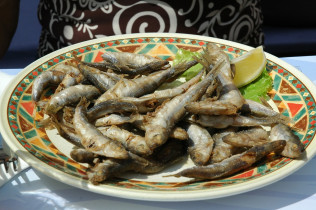Let's get cooking! Sign up for our free meal planner, click here for more details.
A guide to the herb thyme including ideas for use in the kitchen.

Thyme is native to the Mediterranean and Southern European regions and is popular in French cuisine in particular.
It is mixed with parsley and bay leaves to form what is called a bouquet garni and is added to soups, stocks, marinades and stews in order to give them a special herby flavour. Thyme is also one of the dried herbs that make up Herbes de Provence.
Thyme has been grown and used in cooking and medicine for thousands of years.
It is mixed with parsley and bay leaves to form what is called a bouquet garni and is added to soups, stocks, marinades and stews in order to give them a special herby flavour. Thyme is also one of the dried herbs that make up Herbes de Provence.
Thyme has been grown and used in cooking and medicine for thousands of years.
Advertisements
History of thyme
The ancient Egyptians used thyme when embalming their dead pharaohs, as it is a powerful preservative, and the ancient Greeks used to burn thyme in their sacred rituals because of its aromatic smell.
Thyme was also a symbol of bravery and courage and in Medieval times ladies would embroider sprigs of thyme onto a scarf and offer it to their knight.
During the Middle Ages people were given concoctions of thyme to take to treat them against leprosy, the plague, body lice, coughs and digestive problems.
Even today, a major component that is found in thyme is used to make Listerine mouthwash as well as Vicks Vaporub.
Thyme was also a symbol of bravery and courage and in Medieval times ladies would embroider sprigs of thyme onto a scarf and offer it to their knight.
During the Middle Ages people were given concoctions of thyme to take to treat them against leprosy, the plague, body lice, coughs and digestive problems.
Even today, a major component that is found in thyme is used to make Listerine mouthwash as well as Vicks Vaporub.
Nutritional value of thyme
Thyme has a very strong flavour and should therefore be used sparingly. However, 1 teaspoon of fresh thyme does contain a small amount of the daily dosage required of Vitamins A and C. Thyme is also a good source of iron, phosphorous, potassium, zinc and manganese.
Health benefits of thyme
Thyme is a particularly important herb for treating respiratory and chest problems. It works well on colds, coughs, asthma and excess mucous. It helps to clear the lungs and make breathing easier.
Thyme is also said to be good for the following:
Thyme is also said to be good for the following:
- All chest and breathing problems.
- It increases the amount of good fats in the body that are essential to protect the heart.
- Thyme is a good antioxidant.
- It has antibacterial properties.
- Thyme can help to treat some mouth disorders.
- It also has anti-fungal properties and can help to treat athlete's foot.
- It can help to ease all types of cough.
- Thyme may aid digestion.
- It may be use to calm nervousness.
- It can help relieve swelling of joints and other rheumatic conditions.
- Thyme may be used to treat depression.
- It can help with PMT and menopausal symptoms.
Buying and storing thyme
Fresh thyme is a woody small plant, with tiny leaves that must be stripped from the stem before using, which can be quite tricky.
Keep fresh thyme wrapped in a damp paper towel and place it in the refrigerator in order to keep it fresh for longer.
Dried thyme can be bought in airtight glass jars from the supermarket.
Keep fresh thyme wrapped in a damp paper towel and place it in the refrigerator in order to keep it fresh for longer.
Dried thyme can be bought in airtight glass jars from the supermarket.
Ideas for using thyme in the kitchen
Thyme is typically used to make stuffing but is also delicious with all types of beans, for example kidney or pinto beans.
Try some of the following ideas for using thyme in your cooking as well.
Try some of the following ideas for using thyme in your cooking as well.
- Add to bean stews, casseroles and other dishes using beans.
- Add a little thyme to any sauce to go with pasta.
- Sprinkle thyme into scrambled egg or omelette mixtures.
- Add to fish if baking, grilling or poaching.
- Add to soups and stocks for additional flavour.
- Use in marinades for meat, fish and poultry.
- Add to soft cheese and cottage cheese.
- Sprinkle onto salads with cheese.
- Add to breadcrumb mixtures and coat fillets of chicken, veal or turkey and fry.
- Use in homemade stuffing for poultry.
- Sprinkle over lamb or pork chops before grilling.
- Add to a simple tomato, olive oil and vinegar salad.
- Add to homemade beef burger or croquette mixtures.
- Rub thyme into meat before cooking, as it helps to digest the meat.
- Add to dough mixtures for bread and scones.
Advertisements
Thyme Recipes
Three delicious and varied recipes for thyme, including seared scallops with tomato and thyme, potato rösti with garlic and thyme and grilled sardines with thyme.
If you are unsure of how to prepare sardines, try our recipe for grilled sardines with a twist. Serve as a starter or as a main meal with a fresh green salad.
These delicious herby potato rösti can be served as an accompaniment to roast meat. Rösti is the national dish of Switzerland, where it is often eaten for breakfast.
If you are trying to impress with a dish that is a cut above the rest, try this Mediterranean recipe for seared scallops.

